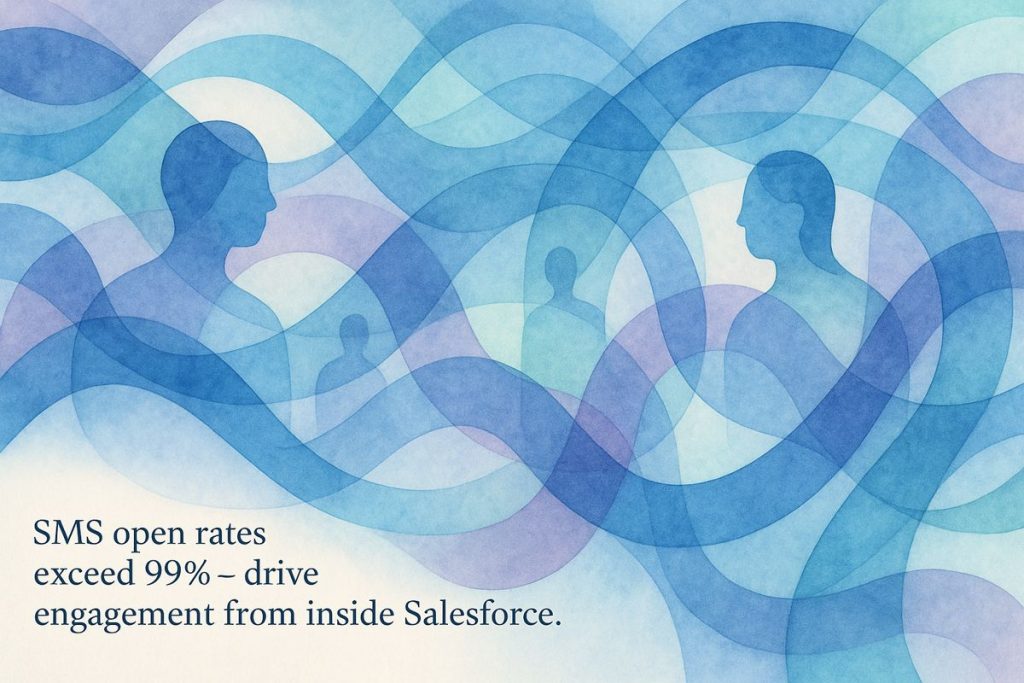Integrating SMS with Salesforce lets companies send instant, personal messages that people almost always read. Every text and reply is tracked, keeping work organized and making it easy to follow rules like GDPR. The right setup can automate reminders, follow-ups, and even let customers opt in or out safely. But with all this power, it’s important not to lose the human touch—because every message could make someone smile or roll their eyes.
What are the benefits of integrating SMS with Salesforce?
Integrating SMS with Salesforce boosts customer engagement by enabling instant, direct messaging with high open rates (over 99%). It ensures all interactions are tracked in Salesforce for compliance and automation, streamlines workflows, and supports secure, personalized communication while helping meet regulations like GDPR and TCPA.
Why Bother? The Strange Power of a Well-Timed Ping
I once sent a text reminder to a customer about their expiring warranty, expecting the usual radio silence. Instead, they replied within two minutes—on a Sunday, no less. That’s the crackling immediacy of SMS: no other channel waltzes past the digital gatekeepers quite like it. Sure, email sits quietly in the corner, but SMS? It’s that friend who bursts through your door, smelling faintly of burnt coffee and opportunity, waving a message you can’t ignore.
Statistically, SMS boasts open rates above 99% (I triple-checked—turns out, it’s not just marketing bravado). TrueDialog and LeadManagerNinja cite response rates eclipsing email and even good old-fashioned phone calls. So why integrate with Salesforce? Because that’s where your customer record palimpsest lives. Marrying SMS to Salesforce means every nudge, query, and virtual handshake is documented—sometimes to an almost forensic degree.
But is there a catch? Let’s say you’re juggling compliance regimes like TCPA or GDPR. Rest easy: the right integration can trace every opt-in and opt-out, encrypt your data, and log consent like a court stenographer. Still, I had to stop and ask myself: does this much oversight ever feel… Orwellian?
Nuts, Bolts, and the Hyperspectral Integration Dilemma
Integration, at its core, is not some mystical alchemy. It’s a hyperspectral process—complex, but not incomprehensible. You’ll choose between Salesforce-native functions (dependable, secure, but sometimes a bit rigid) and the wild, modular world of AppExchange and third-party tools. Heymarket and Textline both offer smorgasbords of features—APIs with the elasticity of taffy, automation that’s almost prescient, and global reach that rivals the International Space Station (okay, illustrative hyperbole).
The secret, I’ve found, lies in mapping your fields precisely: mobile numbers, opt-in histories, quirky custom tags. That, and making sure your messages don’t disappear into the digital ether. One time, I misconfigured a workflow and sent fifty customers identical birthday wishes. On the wrong day. The result? Mild embarrassment, a flurry of confused replies, and a renewed respect for test environments. Lesson learned, though: always dry run your automations.
Data synchronization is the drumbeat here. If a customer opts out via SMS, Salesforce should know before you can say, “Wait, didn’t they want to hear from us?” Bidirectional flows, auto-triggered actions, even personalized nudges—these are your instruments. And what’s that peculiar clicking? Oh, just the sound of automation humming along, like the whir of an old IBM Selectric.
Compliance, Quirks, and the Art of Staying Human
Let’s face it: compliance is to digital messaging what gravity is to flight. Ignore it and, well, splat. Regulations like GDPR, CCPA, and TCPA aren’t paper tigers—they’re enforced, and mistakes cost real rubles (or dollars, but rubles has a certain gravitas). Thankfully, top-tier AppExchange partners build safeguards right in: consent logs, encrypted channels, detailed audit trails. Girikon and 200 OK lay out just how robust these features are.
But this stuff isn’t just for legal eagles. Marketing wants templates that sing—”Hi, Svetlana, your order #84729 ships tomorrow!”—while sales craves real-time follow-ups. Even support teams get in on the action: case updates, survey pings, and those uncanny 3 a.m. auto-replies (I’ve written a few, bleary-eyed, fueled by stale biscotti).
Emotionally? Relief, mostly. Sometimes a twitch of anxiety before hitting send on a mass campaign, but that’s the price of caring about your audience. There’s nothing like seeing a real customer reply—emoji and all—to remind you this isn’t just circuitry at work. It’s connection.
Picking Your Poison and Automating the Rest
Choosing an integration is like picking coffee in Istanbul’s Grand Bazaar: overwhelming, aromatic, and occasionally surreal. Start with CRM Consulting’s roundup—they separate the robust from the rococo. Factor in scale, compliance needs, and whether you want APIs that stretch like Turkish delight.
Templates and auto-responses are your bread and butter. From payment nudges to after-hours apologies—“Sorry, we’re out right now, but your message is warming our servers for Monday”—it’s all possible with Salesforce’s Flow or Process Builder. And every message, inbound or out, is stamped, sorted, and archived. A digital palimpsest, if you will.
In the end, what’s the real secret? Don’t let the technology dull your human edge. If you ever doubt why you’re integrating SMS with Salesforce, just remember: somewhere out there, a customer’s phone lights up, and you’re the reason they smile—or groan. That’s power. That’s risk. That’s the modern dance of engagement… and it smells, faintly, of burnt coffee.
For more wisdom (and a few cautionary tales), check TrueDialog’s guide or 200 OK’s deep dive.
